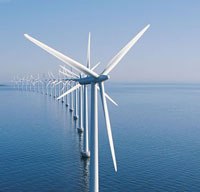| Nov 08, 2013 | |
NSF $400K grant to research turbulence caused wear and tear on wind turbines |
|
| (Nanowerk News) Although wind resources in the United States are abundant, the cost of generating wind energy is still prohibitively expensive when compared to natural gas and fossil fuels. Researchers have documented that one of the key reasons the costs remain high is because wind turbines have shorter lifespans compared to other energy-producing technologies, which can be directly linked to wear and tear caused by turbulence. | |
 Turbulence, which is often associated with bumpy airplane rides, is the primary reason that wind turbines do not perform at their optimal capacity. In a wind farm, or cluster of wind turbines, turbulence occurs from multiple physical processes arising from the wind, atmosphere, complex terrain and the rotor blades. Finding a solution to this problem is precisely what Kiran Bhaganagar, University of Texas at San Antonio (UTSA) researcher and assistant professor of mechanical engineering, plans to do with the support of three National Science Foundation (NSF) grants. Bhaganagar graduated from Cornell University under the tutelage of John Lumley, a legend in the field of turbulence, and has years of experience mastering the fundamental physics and mathematical framework of turbulence. Totaling $400,000, the grants will allow Bhaganagar and her team of undergraduate and graduate students to pursue critical wind energy research on both land-based and offshore wind turbines to determine the optimal mechanical and aerodynamic conditions of the turbines. "Our ultimate vision is to contribute to lowering the cost of generating wind energy by working with industries and federal agencies on what we discover is the most effective design and placement of turbines over complex terrains," said Bhaganagar. |
|
| This is the first time that a scholar in the UTSA Simulation, Visualization and Real-time Prediction (SiViRT) Center will study wind energy. Scholars in the center use computer simulation, high-performance computing and advanced visualization to research various topics in engineering and science with broad applications. | |
| "Receiving NSF grants is important to UTSA as they invest in high-impact research of intellectual quality and excellence in education," said Mehdi Shadaram, interim dean of the UTSA College of Engineering. "Professor Bhaganagar is leading an important new research initiative for the college that will attract and generate top-quality students." | |
| Using advanced computational modeling, the team will generate one of the first accurate representations of the detailed aerodynamics of tall, multi-megawatt, rotating wind turbines. The model will simulate 24-hour atmospheric conditions over complex terrains to accurately predict the power output from a wind farm. The simulations will be performed on a 6,400-node stampede cluster, one of the most powerful supercomputers in the world. | |
| Preliminary studies by Bhaganagar's team have revealed that wake effects of the upstream turbines significantly affect downstream wind turbines, reducing their power by roughly 40 percent. The wake effects are cumulative, so each additional downstream turbine performs less and less efficiently. | |
| Their research is expected to greatly enhance the fundamental science of wind engineering and the future of wind farm installations. | |
| As one of few females in a historically male-dominated field, Bhaganagar is motivated to encourage more young women to pursue careers in engineering. | |
| "One of my goals is to motivate and train young females in wind energy so that they can be a part of the solution to the world's energy crisis and an impending issue facing our country," she said. | |
| Bhaganagar will conduct the research in partnership with the National Renewable Energy Laboratory and the National Wind Resource Center at Texas Tech University. Bhaganagar also has established strong ties with the Technical University of Denmark, the world leader in wind energy research. |
| Source: University of Texas at San Antonio |

